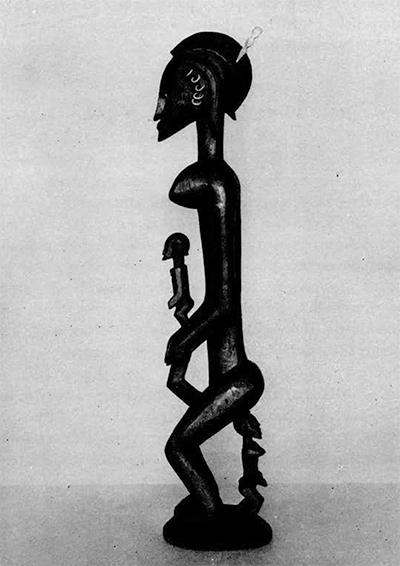IN the spring the Museum secured a large and important collection of over two hundred masks and wooden statuettes from the Ivory Coast, the French Soudan, the French Congo, and Dahomey. Most of the specimens are extremely rare, some unique. The highly stylized Nafara mask surmounted by the figure of a bird which is reproduced in a line drawing on the cover of this issue of the Bulletin is an example of the conventionalization which is an essential feature of all negro representative art. Even in the most nearly realistic attempts to reproduce the human form a drastic simplification of contours and of the details of modelling shows itself. The sculpture of the Ivory Coast provides excellent examples of the progress of stylization through a series of phases in pieces which are contemporary with one another.

Museum Object Number: 29-12-68

Image Number: 1003
The figure of a woman [Plate X] with a child on her back is a good example of such realism as is achieved by these inveterate conventionalizers. The highly decorative impression created by the treatment of the hair and by the apparent elaboration of the design in raised scar tattooing is provided for the artist in his observation of the face and body of living models. The face, with its severely simplified outlines, has gone far in the direction of becoming a mere decoration, yet the contact with reality is never entirely lost even when style has apparently come to be the dominant consideration; the product is recognizably human and alive.

Museum Object Number:29-35-14
Image Number: 725
The Habe, driven by the movements set up by Moslem invaders, have taken to the high plateau in the how of the Niger, retaining their pagan beliefs and practices. A conception of a female spirit responsible for maternity and fertility in general is an important feature of Habe religion. The statuette [Plate XI] represents a phase or an outgrowth of her activities. It is a “goddess” of childbirth. The Habe style in wood sculpture is highly individual-rather gauche yet direct and impressive.
The second collection comprises twenty-five masks largely from the same regions as the above. Most of these are also extremely rare specimens. The one illustrated [Plate XII] has particular interest in that it displays the distinctive facial marks of the Taguana tribe to which it belonged, a long curved weal across each cheek, made by introducing an irritant into incisions in the skin.
The addition of these two extensive groups of sculpture make the Museum’s collections of negro art undoubtedly the most important in America.

